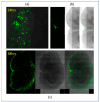Molecular Engineering of Virus Tropism
- PMID: 39456875
- PMCID: PMC11508178
- DOI: 10.3390/ijms252011094
Molecular Engineering of Virus Tropism
Abstract
Engineered viral vectors designed to deliver genetic material to specific targets offer significant potential for disease treatment, safer vaccine development, and the creation of novel biochemical research tools. Viral tropism, the specificity of a virus for infecting a particular host, is often modified in recombinant viruses to achieve precise delivery, minimize off-target effects, enhance transduction efficiency, and improve safety. Key factors influencing tropism include surface protein interactions between the virus and host-cell, the availability of host-cell machinery for viral replication, and the host immune response. This review explores current strategies for modifying the tropism of recombinant viruses by altering their surface proteins. We provide an overview of recent advancements in targeting non-enveloped viruses (adenovirus and adeno-associated virus) and enveloped viruses (retro/lentivirus, Rabies, Vesicular Stomatitis Virus, and Herpesvirus) to specific cell types. Additionally, we discuss approaches, such as rational design, directed evolution, and in silico and machine learning-based methods, for generating novel AAV variants with the desired tropism and the use of chimeric envelope proteins for pseudotyping enveloped viruses. Finally, we highlight the applications of these advancements and discuss the challenges and future directions in engineering viral tropism.
Keywords: AAV; AAV serotype; AAV variant; HSV; capsid; g-deleted rabies virus; lentivirus; pseudotyping virus; retrovirus; viral application; viral vectors; virus envelope; virus envelope chimera.
Conflict of interest statement
The authors declare no conflicts of interest.
Figures


References
-
- Mueller S.N., Rouse B.T. Clinical Immunology. Mosby; Maryland Heights, MI, USA: 2008. Immune responses to viruses; pp. 421–431. - DOI
-
- Woodham A.W., Skeate J.G., Sanna A.M., Taylor J.R., Da Silva D.M., Cannon P.M., Kast W.M. Human Immunodeficiency Virus Immune Cell Receptors, Coreceptors, and Cofactors: Implications for Prevention and Treatment. AIDS Patient Care STDS. 2016;30:291–306. doi: 10.1089/apc.2016.0100. - DOI - PMC - PubMed
Publication types
MeSH terms
Grants and funding
LinkOut - more resources
Full Text Sources

